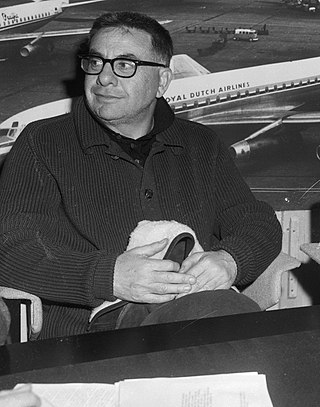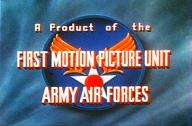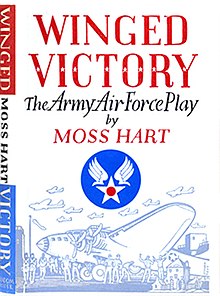
Martin Ritt was an American director and actor who worked in both film and theater, noted for his socially conscious films.

The 557th Weather Wing is a United States Air Force formation and its lead military meteorology center. It reports environmental situational awareness worldwide to the Air Force, the United States Army, joint warfighters, Unified Combatant Commands, the national intelligence community, and the Secretary of Defense. It is headquartered at Offutt Air Force Base, in Bellevue, Nebraska.

Irving Paul "Swifty" Lazar was an American talent agent and dealmaker, representing both movie stars and authors.

The 18th AAF Base Unit, originally known as the First Motion Picture Unit, Army Air Forces, was the primary film production unit of the U.S. Army Air Forces (AAF) during World War II, and was the first military unit made up entirely of professionals from the film industry. It produced more than 400 propaganda and training films, which were notable for being informative as well as entertaining. Films for which the unit is known include Resisting Enemy Interrogation, Memphis Belle: A Story of a Flying Fortress and The Last Bomb—all of which were released in theatres. Veteran actors such as Clark Gable, William Holden, Clayton Moore, Ronald Reagan, and DeForest Kelley, and directors such as John Sturges served with the 18th AAF Base Unit. The unit also produced training films and trained combat cameramen.

Harry Horner was a German Bohemian-born American art director who made a successful career in Hollywood as an Oscar-winning art director and as a feature film and television director.

The 346th Bombardment Group is a former United States Army Air Forces unit. It was last assigned to the 316th Bombardment Wing at Kadena Airfield, Okinawa, where it was inactivated on 30 June 1946. The group was originally a heavy bomber training unit, but was inactivated in a general reorganization of Army Air Forces training units in 1944. It was reorganized as a Boeing B-29 Superfortress group later that year. It moved to Okinawa in 1945, but arrived too late to participate in combat.

The 400th Tactical Missile Wing is an inactive United States Air Force unit. It was last active as the 400th Bombardment Group, a World War II Consolidated B-24 Liberator Replacement Training Unit. The unit was disbanded in 1944 in a general reorganization of Army Air Forces training units. It was reconstituted as a missile wing in 1985, but has not been active since then.

The United States Army Air Forces during World War II had major subordinate Commands below the Air Staff level. These Commands were organized along functional missions. One such Command was the Flying Training Command (FTC). It began as Air Corps Flying Training Command on 23 January 1942, was redesignated Army Air Forces Flying Training Command (AAFTC) on 15 March 1942, and merged with Army Air Forces Technical Training Command to become Army Air Forces Training Command on 31 July 1943. Continuing service after the war, it was redesignated Air Training Command on 1 July 1946. During the consolidation of Air Force Major Commands in the retrenchment of the 1990s, Air Training Command assumed control of Air University and became Air Education and Training Command on 1 July 1993—today's Air Education and Training Command (AETC), which celebrated its 75th anniversary 23 January 2017. see the Lineage and honors statement for AETC.

The I Troop Carrier Command is a disbanded United States Air Force unit. Its last assignment was with Continental Air Forces, at Stout Field, Indiana, where it was disbanded in November 1945, and its resources transferred to IX Troop Carrier Command.
The Los Angeles Fighter Wing was a unit of the United States Army Air Forces. The wing provided air defense of southern California and trained fighter units and pilots. It was stationed at Los Angeles, California, where it was disbanded on 7 June 1944.

The San Francisco Fighter Wing is a disbanded United States Air Force unit. The wing provided air defense of the central Pacific coast and trained fighter units and pilots. It was stationed at San Francisco, California, where it was disbanded on 7 June 1944.

Winged Victory is a 1944 American drama film directed by George Cukor, a joint effort of 20th Century-Fox and the U.S. Army Air Forces. Based upon the 1943 play of the same name by Moss Hart, who also wrote the screenplay, the film opened only after the play's theatre run. The film version of Winged Victory used many of the Broadway cast, who were brought to Hollywood.

The United States Army Air Forces was the major land-based aerial warfare service component of the United States Army and de facto aerial warfare service branch of the United States during and immediately after World War II (1941–1947). It was created on 20 June 1941 as successor to the previous United States Army Air Corps and is the direct predecessor of the United States Air Force, today one of the six armed forces of the United States. The AAF was a component of the United States Army, which on 2 March 1942 was divided functionally by executive order into three autonomous forces: the Army Ground Forces, the United States Army Services of Supply, and the Army Air Forces. Each of these forces had a commanding general who reported directly to the Army Chief of Staff.

The 469th Bombardment Group is a former United States Army Air Forces (AAF) unit. It was activated in May 1943 and served as a Replacement Training Unit until it was disbanded in April 1944 when the AAF reorganized its training and support units in the United States.
The 418th Bombardment Group is the designation held by two United States Army Air Forces advanced training units, briefly active during World War II. The two groups were consolidated in 1958 and redesignated the 418th Tactical Missile Wing in 1985, but the consolidated unit has never been active.

The 88th Bombardment Group is an inactive United States Air Force unit. During World War II, the group served as a training unit for Boeing B-17 Flying Fortress units and aircrews. It was inactivated in May 1944, when the Army Air Forces reorganized its training units, replacing units like the 88th that were organized under rigid tables of organization.

The 408th Armament Systems Group is an inactive United States Air Force (USAF) unit. Its last assignment was with Air Force Materiel Command's 308th Armament Systems Wing at Eglin Air Force Base, Florida. It was inactivated in 2010.

Dixon Howard "Dick" Hogan was an American actor of the 1930s and 1940s. During his 12-year career he appeared in over three dozen films, in roles which varied from unnamed bellhops to featured and starring roles. His final film performance was as the murder victim in Alfred Hitchcock's Rope (1948).

The 496th Fighter Training Group (FTG) was a United States Army Air Forces unit, serving with the Eighth Air Force in the United Kingdom during World War II. Activated in December 1943, the unit trained replacement pilots on the Lockheed P-38 Lightning and later the North American P-51 Mustang. In October 1944 its training mission was ended when the Eighth Air Force decided to instead train pilots in operational training units that were part of combat fighter groups. For the remainder of its service, the group provided support services for units at RAF Halesworth, including an air-sea rescue squadron. The group was inactivated in April 1945; its attached units were directly subordinated to the 65th Fighter Wing and remaining personnel transferred to an air service squadron.

Phyllis Avery was an American actress.

















